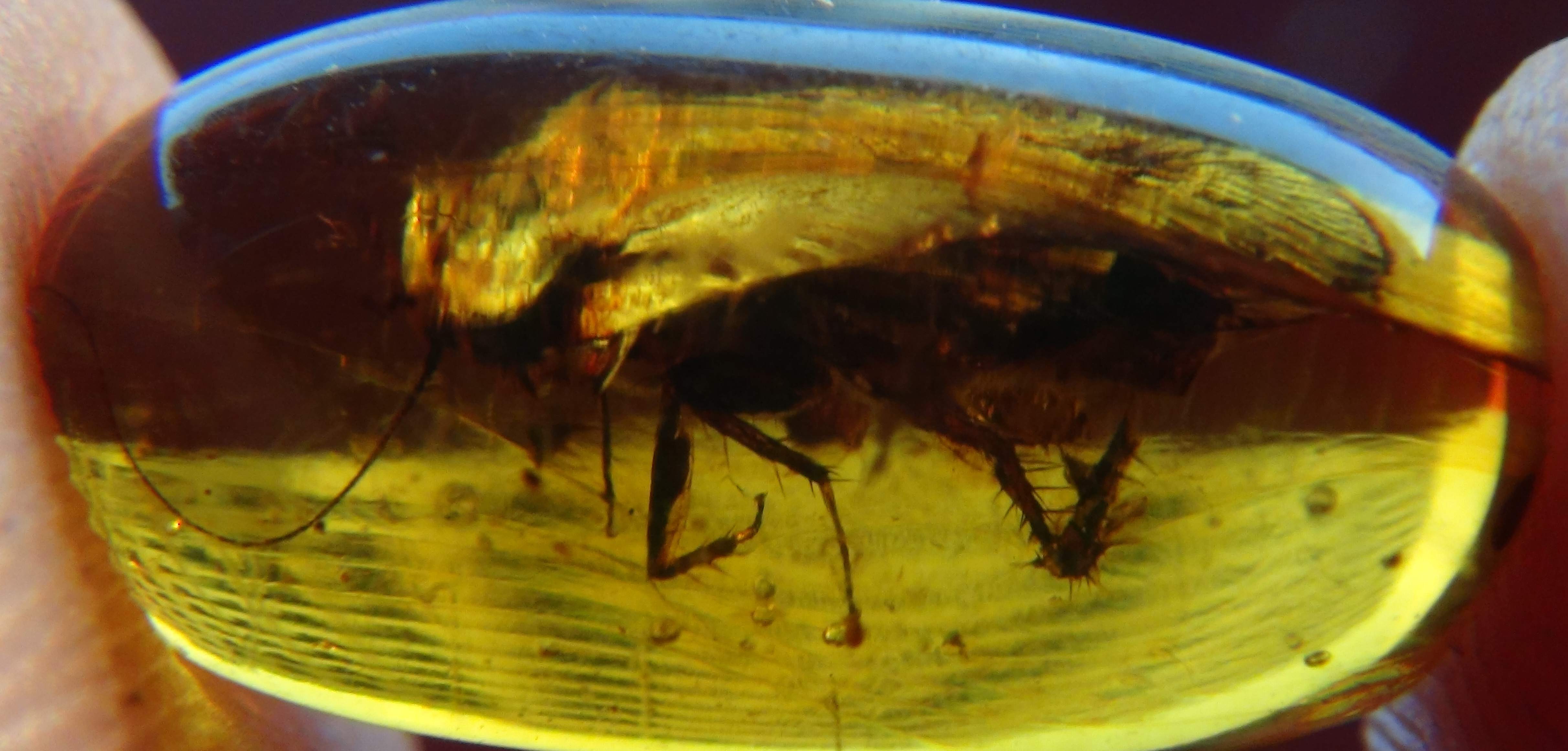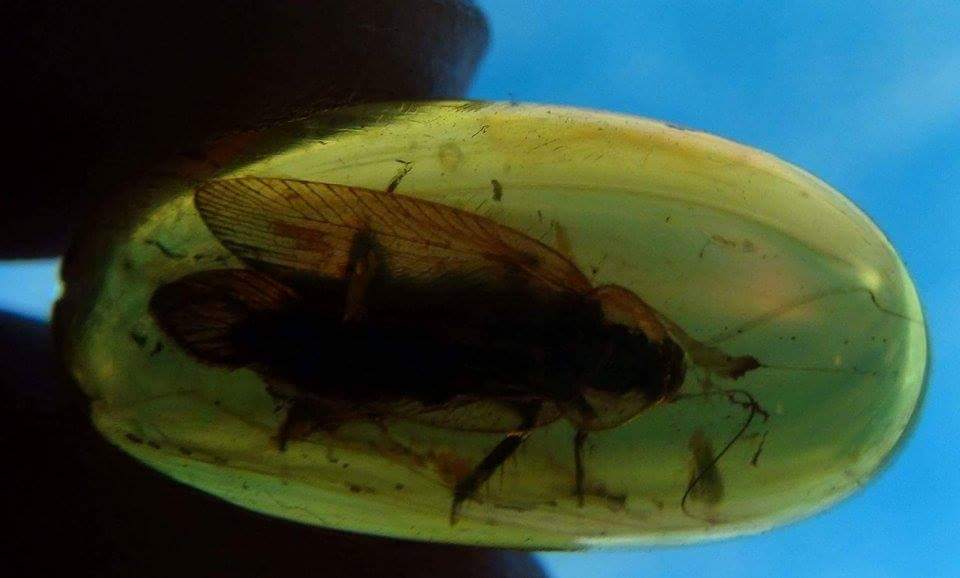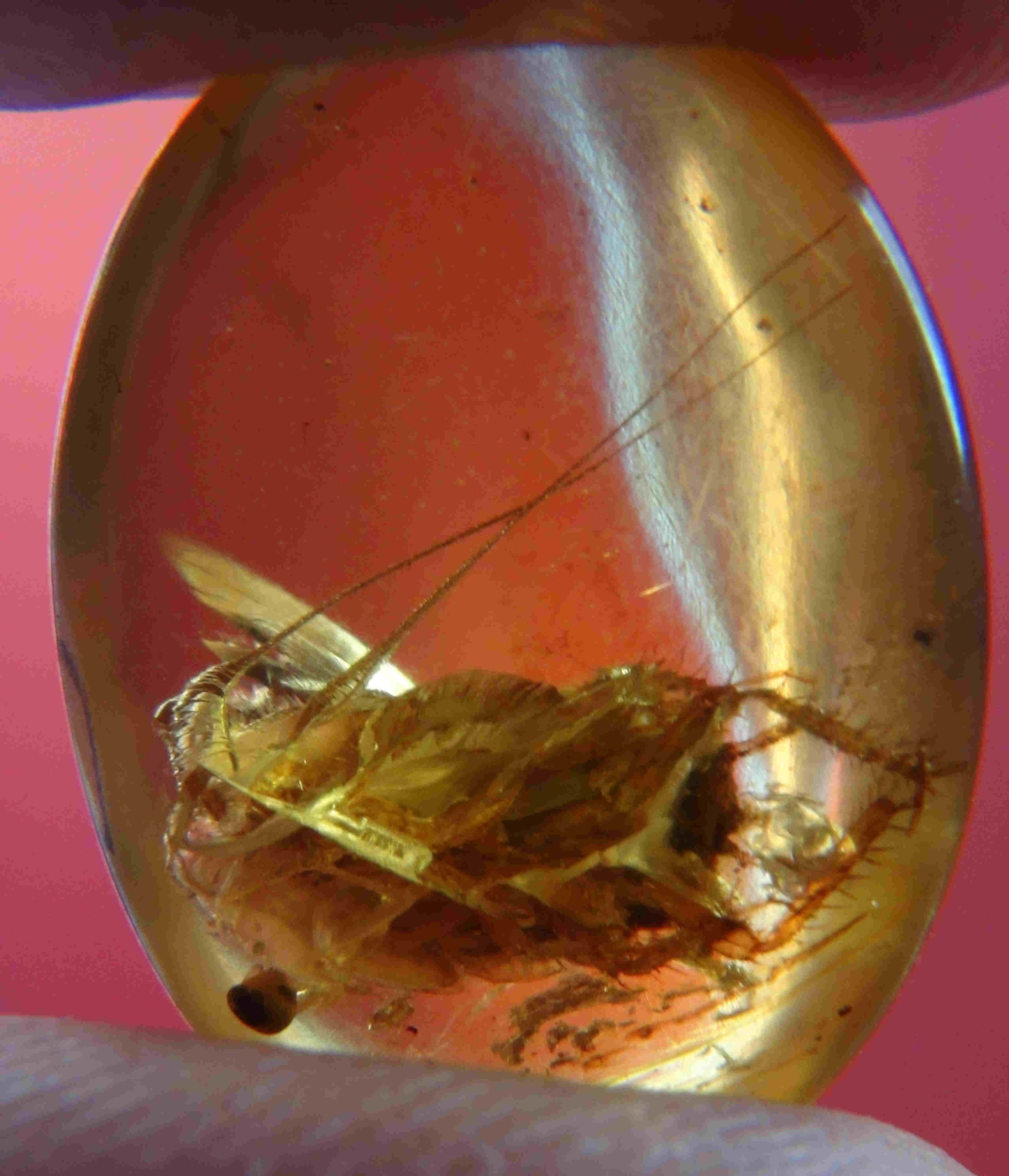Cockroach in burmite amber. Predatory cockroach from dinosaur era have been found trapped in Myanmar amber. An exotic, praying-mantis-like cockroach that lived at the same time as dinosaurs was caught in amber about 100 million years ago. It is part of a new family of extinct predatory cockroaches that hunted at night.
Peter Vršanský from the Geological Institute in Bratislava, Slovakia, and Günter Bechly from the State Museum of Natural History in Stuttgart, Germany, who examined the insect, say its long neck, which allows the head to rotate freely, and unusually long legs, suggest that it actively pursued prey. The fossilised insect, called Manipulator modificaputis, was discovered at a mine in Noije Bum, Myanmar.
During the early Cretaceous period when it lived, several predatory cockroach-like lineages evolved. Only one group survives today: the praying mantises, which have similar front legs to the fossil, and are closely related to cockroaches..
The specimen is one of dozens of preserved insects found in the area, making it the most important site of dinosaur-age amber in the world, says Vršanský. Many large pieces of amber contained complete adult insects, which should help reconstruct the history of the animals and their ecosystem. In Lebanese amber 130 millions old it is reported that a poisonous cockroach was found.

Cockroach in amber

This one has a double-tail

Important Cockroaches found in Kachin amber
Archimylacris eggintoni: Description: One of the earliest known cockroach species in Burmese amber. Exhibits primitive features, such as the presence of wing pads, suggesting an early stage in cockroach evolution. Cretaholocompsa montsecana: Description: Well-preserved wing venation provides insights into the flight adaptations and wing morphology of ancient cockroaches. Cylindroblatta wui: Description: Characterized by a slender and elongated body, unique among Burmese amber cockroaches. Electroblattula itzaina: Description: Known for its well-preserved antennae, offering insights into sensory adaptations and antennal structures of ancient cockroaches. Burmaplecta feldmanni: Description: Distinctively long legs, suggesting possible adaptations for specific locomotor behaviors or habitats in the ancient ecosystem. Cretaholocompsa gracilis: Description: Notable for its delicate and slender body structure, contributing to the diversity of body shapes among ancient cockroach species. Eooblattida incertae sedis: Description: Classified in the group Eooblattida, representing a unique and early representative of the group, pending further taxonomic studies.Members of the Cockroach Family found in Burmite including termite brothers
Blattodea (incl. Isoptera) (8f., 10g., 11sp.)
†Archeorhinotermitidae
Archeorhinotermes rossi Krishna & Grimaldi, 2003
†Caloblattinidae
Raphidiomimula burmitica Grimaldi & Ross, 2004
Corydiidae (=Polyphagidae)
Ectobiidae (=Blattellidae)
Hodotermitidae?
Kalotermitidae
Kalotermes burmensis Poinar, 2009
Proelectrotermes holmgreni Engel, Grimaldi & Krishna, 2007
Proelectrotermes swinhoei (Cockerell, 1916)
Termitidae?
†Umenocoleidae (=Ponopterixidae)
Family incertae sedis
Dharmatermes avernalis Engel, Grimaldi & Krishna, 2007
Ginormotermes rex (Engel, Barden & Grimaldi, 2016)
Kachinitermes tristis (Cockerell, 1917)
Krishnatermes yoddha Engel, Barden & Grimaldi, 2016
Mylacrotemes cordatus Engel, Grimaldi & Krishna, 2007
Tanytermes anawrahti Engel, Grimaldi & Krishna, 2007
Papers written on cockroaches in amber
Grimaldi, D.A. & Ross, A.J. 2004. Raphidiomimula, an enigmatic new cockroach in Cretaceous amber from Myanmar (Burma) (Insecta: Blattodea: Raphidiomimidae). Journal of Systematic Palaeontology, 2(2), 101-104.
Zhang, W., Guo, M., Yang, X. & Bai, M. 2016. A new species of ice crawlers from Burmese amber (Grylloblattodea). Zoological Systematics, 41(3), 327-331.
Poinar, G.O.Jr. 2009d. Early Cretaceous protist flagellates (Parabasalia: Hypermatigia: Oxymonada) of cockroaches (Insecta: Blattaria) in Burmese amber. Cretaceous Research, 30, 1066-1072.
Abstract Two Early Cretaceous Burmese amber cockroaches contained protists related to mutualistic flagellates occurring in extant Cryptocercus cockroaches and lower termites. The fossil protists are described as Devescovites proteus Poinar n. gen., n. sp. (Parabasalia: Trichomonadida: Devescovinidae), Paleotrichomones burmanicus Poinar n. gen., n. sp. (Parabasalia: Trichomonida), Burmanymphus cretacea Poinar n. gen., n. sp. (Hypermastigia: Trichonymphida: Burmanymphidae n. fam.) and Oxymonas gigantea Poinar, n. sp. Additional putative protists are also illustrated. Evolutionary implications of this discovery are discussed.Vršanský, P. & Bechly, B. 2015. New predatory cockroaches (Insecta: Blattaria: Manipulatoridae fam. n.) from the Upper Cretaceous Myanmar amber. Geologica Carpathica, 66 (2), 133-138.
Abstract: We describe a new extinct lineage Manipulatoridae (new family) of cockroaches from the Upper Cretaceous (Cenomanian) amber of Myanmar. Manipulator modificaputis gen. et sp. n. is a morphologically unique extinct cockroach that represents the first (of a total of 29 known worldwide) cockroach family reported exclusively from the Myanmar amber. This family represents an early side branch of the stem group of Mantodea (most probably a sister group of Eadiidae within Blattaria/Corydioidea) because it has some synapomorphies with the Mantodea (including the stem group and Eadiidae). This family also retains symplesiomorphies that exclude a position in the crown group, and furthermore has unique autapomorphies that exclude a position as a direct ancestor of Mantodea. The unique adaptations such as strongly elongated extremities and freely movable head on a long neck suggest that these animals were pursuit predators. Five additional specimens (including two immatures) reported from the Myanmar amber suggest that this group was relatively rare but belonged to the indigenous and autochthonous inhabitants of the ancient amber forest of the Myanmar region.
Big predatory dictyopterans are represented mostly by praying mantises (Mantodea), which can be derived from extinct cockroaches, as recently summarized by Hörnig et al. (2013) and Lee (2014), namely from the family Liberiblattinidae (Vršanský 2002). Nevertheless, some other Mesozoic lineages of cockroaches that are well studied also possessed predatory lifestyles (e.g. on the basis of their gut-content). These include representatives of the families Raphidiomimidae and Eadiidae, both occurring in the Jurassic sediments and Cretaceous ambers, although they are missing in some of the richest fossiliferous Cretaceous sediments (Vishniakova 1973; Vršanský 2003, 2009; Grimaldi 2003; Liang et al. 2009, 2012). The amber record includes Raphidiomimula burmitica (herein categorized within Eadiidae) from Myanmar (Grimaldi & Ross 2004), but also many more unstudied species of both families. Here, we describe the holotype specimen of a new species belonging to a morphologically-deviant new family. This species was probably a pursuit predator, filling a niche previously not exploited by extinct cockroaches, differing from pursuit predatory behaviour of the significantly larger and more robust (with extremities of standard length) and phylogenetically different Raphidiomimidae (Caloblattinoidea) that differ in their prognathous head and short neck
Liang, J.-H., Vršanský, P., Ren, D. & Shih, C. 2009. A new Jurassic carnivorous cockroach (Insecta, Blattaria, Raphidiomimidae) from the Inner Mongolia in China. Zootaxa, No. 1974, 17-30.



